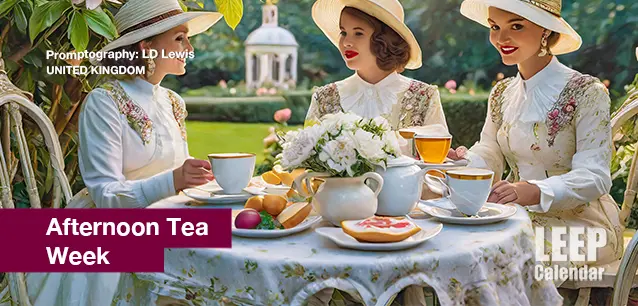 AD
AD
Today is: December 17
Scroll to explore events active on this date.
Additional Events on LEEP
LEEP INK FEATURES

August? Absolutely!
In August, we live through the Dog Days of Summer. It's hot and often humid, and those who can leave for better climates do. Down south, winter is in full force. August is also known as "the ...

In The Heat of July: July 2025 Events
Is it hot enough (or cold enough if you're below the equator) for you yet? There is actually a day for that! Like every month, I pick a diverse collection of events you may or may not know about. This ...

May Blooms: Events in May 2025
Along with October, May is one of the most densely packed months of the year. It's before the summer humidity and the last whole month of the school year. The weather is warming in t...
About Afternoon Tea Week
Ends: Aug 18, 2024
DESCRIPTION:
AFTERNOON TEA—A BRITISH TRADITION
The afternoon tea ritual holds a cherished place in British culture. This time-honored custom, often enjoyed between 3:30 and 5 PM, is more than just a meal; it reflects the nation's affinity for elegance and refinement.TEA TIDBITS
Afternoon tea typically consists of a delightful assortment of sandwiches, scones, cakes, and pastries. Finger sandwiches cut in small squares or rectangles filled with cucumber smoked salmon, egg and watercress, or ham and mustard provide a savory start. Part two includes scones. Scones are broken in half and never cut. Next, dab a dollop of clotted cream and jam on the plate, never directly on the scone when serving. The final tier of tea presents an array of cakes and pastries, featuring everything from Victoria Sponge and Battenberg cake to delicate éclairs and macaroons.PREPARING THE PERFECT CUP OF ENGLISH TEA
Properly preparing a cup of tea is an art form in England. The process begins with fresh, cold water brought to a rolling boil. Loose-leaf tea (2 grams per cup) is placed in a teapot and warmed with hot water before brewing. Boiling water is added to the damp tea leaves and set aside to steep for three to five minutes, depending on the desired strength.
Next, milk and sugar (or lemon for some) are added to the cup if desired. This prevents the milk from scalding. Once added, situate a strainer over the teacup and pour the steeped tea into the stainer. The stainer will catch the loose tea leaves. After pouring the tea, stir it in a lateral motion from six to twelve back and forth with the concaved spoon facing you—not round and round, an action that splashes and fails to dissolve the sugar well.A HISTORICAL NECESSITY TURNED CULTURAL ICON
Tea became the official court beverage in England around 1662 when the dowry of a Portuguese princess, Catherine of Braganza, included it upon her marriage to Charles II.
The idea of afternoon tea originated with Anna Russell, the seventh Duchess of Bedford, around 1840. The time between lunch and dinner (Noon and 8 PM) seemed forever, and afternoon tea provided the opportunity for a light snack and socializing. The Duchess found herself experiencing a "sinking feeling" in the late afternoon. She began inviting friends to join her for an additional meal of tea and light refreshments.
The practice quickly gained popularity, evolving from a private social event into a widespread societal custom. Today, afternoon tea is celebrated both in homes and in upscale hotels, where it serves as a symbol of British hospitality and genteel leisure.
Whether enjoyed in the lush settings of a country garden or the refined ambiance of a London tea room, afternoon tea remains a quintessentially British experience, embodying the nation's love for tradition and friendliness.
This event first occurred in 2010 and was created by Keith Newton.
VIDEOS
SUPPORTING DOCUMENTS
Currently, this event does not have supporting documents.
ADDITIONAL IMAGES
Currently, this event does not have supporting images.
Where would you like to go now?
 AD
AD


/footer-logo.svg)
